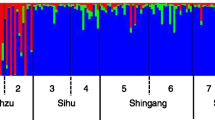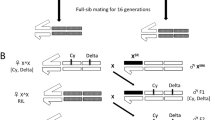Abstract
The factors maintaining sex chromosome meiotic drive, or sex ratio (SR), in natural populations remain uncertain. Coevolution between segregation distortion and modifiers should produce transient SR distortion while selection can result in a stable polymorphism. We hypothesize that if SR is maintained by selection, then phylogenetically related populations should exhibit similar SR frequency and intensity. Furthermore, when drive is present, females should mate with multiple males more often both to insure fertility and to increase the probability of producing male progeny. In this paper we report on variation in SR frequency and multiple mating among seven populations and three species of stalk-eyed flies, genus Cyrtodiopsis, from southeast Asia. Using a phylogenetic hypothesis based on 1100 bp of mtDNA sequence we find that while sex chromosome meiotic drive is present in all populations of C. whitei and C. dalmanni, the frequency and intensity of drive only differs between populations or species with greater than 4.8% sequence divergence. The frequency of females mating with multiple males is higher in populations with SR. In addition, SR males mate less often, possibly to compensate for sperm depletion. Our results suggest that sex chromosome drive is maintained by balancing selection in populations of C. whitei and C. dalmanni. Nevertheless, coevolution between drive and suppressors deserves further study.
Similar content being viewed by others
References
Atlan, A., H. Mercot, C. Landre & C. Montchamp-Moreau, 1997. The sex-ratio trait in Drosophila simulans: Geographical distribution of distortion and resistance. Evolution 51: 1886–1895.
Baker, R.H., G.S. Wilkinson & R. Desalle, 2001. The phylogenetic utility of different types of molecular data used to infer evolutionary relationships among stalk-eyed flies (Diopsidae). Syst. Biol. 50: 87–105.
Ballard, J.W.O., B. Chernoff & A.C. James, 2002. Divergence of mitochondrial DNA is not corroborated by nuclear DNA, morphology, or behavior in Drosophila simulans. Evolution 56: 527–545.
Beckenbach, A.T., 1996. Selection and the 'sex-ratio' polymorphism in natural populations of Drosophila pseudoobscura. Evolution 50: 787–794.
Carvalho, A.B. & S.C. Vaz, 1999. Are Drosophila SR chromosomes always balanced? Heredity 83: 221–228.
Carvalho, A.B., S.C. Vaz & L.B. Klaczko, 1997. Polymorphism for Y-linked suppressors of sex-ratio in two natural populations of Drosophila mediopunctata. Genetics 146: 891–902.
Cazemajor, M., C. Landre & C. Montchamp-Moreau, 1997. The sex-ratio trait in Drosophila simulans: genetic analysis of distortion and suppression. Genetics 147: 635–642.
Cazemajor, M., D. Joly & C. Montchamp-Moreau, 2000. Sex-ratio meiotic drive in Drosophila simulans is related to equational nondisjunction of the Y chromosome. Genetics 154: 229–236.
Coyne, J.A. & H.A. Orr, 1993. Further evidence against meioticdrive models of hybrid sterility. Evolution 47: 685–687.
Coyne, J.A., B. Charlesworth & H.A. Orr, 1991. Haldane rule revisited. Evolution 45: 1710–1714.
David, P., T. Bjorksten, K. Fowler & A. Pomiankowski, 2000. Condition-dependent signalling of genetic variation in stalk-eyed flies. Nature 406: 186–188.
De La Motte, I. & D. Burkhardt, 1983. Portrait of an Asian stalkeyed fly. Naturwiss 70: 451–461.
Dobzhansky, T., 1958. Genetics of natural populations. XXVII. The genetic changes in populations of Drosophila pseudoobscura in the American Southwest. Evolution 12: 385–401.
Edwards, A.W.F., 1961. The population genetics of 'sex-ratio' in Drosophila pseudoobscura. Heredity 16: 291–304.
Fisher, R.A., 1958. The Genetical Theory of Natural Selection. Dover, New York.
Frank, S.A., 1991. Divergence of meiotic drive-suppression systems as an explanation for sex-biased hybrid sterility and inviability. Evolution 45: 262–267.
Haig, D. & C.T. Bergstrom, 1995. Multiple mating, sperm competition and meiotic drive. J. Evol. Biol. 8: 265–282.
Halliday, T. & S. Arnold, 1987. Multiple mating by females-a perspective from quantitative genetics. Anim. Behav. 35: 939–941.
Hamilton, W.D., 1967. Extraordinary sex ratios. Science 156: 477–488.
Hannebuth, T., K. Stattegger & P.M. Grootes, 2000. Rapid flooding of the Sunda shelf-a late-glacial sea-level record. Science 288: 1033–1035.
Hauschteck-Jungen, E., 1990. Postmating reproductive isolation and modification of the sex-ratio trait in Drosophila subobscura induced by the sex chromosome gene arrangement A2+3+5+7. Genetica 83: 31–44.
Hurst, L. & A. Pomiankowski, 1991. Causes of sex ratio bias may account for unisexual sterility in hybrids: a new explanation of Haldane's rule and related phenomenon. Genetics 128: 841–858.
Jaenike, J., 1996. Sex-ratio meiotic drive in the Drosophila quinaria group. Am. Nat. 148: 237–254.
Jiggins, F.M., G.D.D. Hurst & M.E.N. Majerus, 1999. How common are meiotically driven sex chromosomes? Am. Nat. 154: 481–483.
Johnson, N.A. & C.-I. Wu, 1992. An empirical test of the meiotic drive models of hybrid sterility: sex-ratio data from hybrids between Drosophila simulans and Drosophila sechellia. Genetics 130: 507–511.
Lande, R. & G.S. Wilkinson, 1999. Models of sex-ratio meiotic drive and sexual selection in stalk-eyed flies. Genet. Res. 74: 245–253.
Lorch, P., G.S. Wilkinson & P.R. Reillo, 1993. Copulation duration and sperm precedence in the Malaysian stalk-eyed fly, Cyrtodiopsis whitei (Diptera: Diopsidae). Behav. Ecol. Sociobiol. 32: 303–311.
Lyttle, T.W., 1991. Segregation distorters. Ann. Rev. Genetics 25: 511–557.
Lyttle, T.W., 1993. Cheaters sometimes prosper: distortion of Mendelian segregation by meiotic drive. Trends Genet. 9: 205–208.
Markow, T.A., 1996. Evolution of Drosophila mating systems. Evol. Biol. 29: 73–106.
Montchamp-Moreau, C. & D. Joly, 1997. Abnormal spermiogenesis is associated with the X-linked sex-ratio trait in Drosophila simulans. Heredity 79: 24–30.
Orr, H.A. & D.C. Presgraves, 2000. Speciation by postzygotic isolation: forces, genes and molecules. Bioessays 22: 1085–1094.
Owusu-Daaku, K.O., R.J. Wood & R.D. Butler, 1997. Selected lines of Aedes aegypti with persistently distorted sex ratios. Heredity 79: 388–393.
Palopoli, M.F. & C.-I. Wu, 1996. Rapid evolution of a coadapted gene complex: evidence from the segregation distorter (SD) system of meiotic drive in Drosophila melanogaster. Genetics 143: 1675–1688.
Pomiankowski, A. & L.D. Hurst, 1993. Genomic conflicts underlying Haldane's rule. Genetics 133: 425–432.
Presgraves, D.C., E. Severence & G.S. Wilkinson, 1997. Sex chromosome meiotic drive in stalk-eyed flies. Genetics 147: 1169–1180.
Reinhold, K., 1998. Sex linkage among genes controlling sexually selected traits. Behav. Ecol. Sociobiol. 44: 1–7.
Ritchie, M.G., 2000. The inheritance of female preference functions in a mate recognition system. Proc. R. Soc. Lond. B 267: 1–6.
Stalker, H.D., 1961. The genetic systems modifying meiotic drive in Drosophila paramelanica. Genetics 46: 177–202.
Steyskal, G.C., 1972. A catalogue of species and key to the genera of the family Diopsidae. Stuttg. Beitr. Naturkd. Ser. A 1–20.
Swofford, D.L., 2001 PAUP?: Phylogenetic Analysis Using Parsimony (and Other Methods), Version 4.0b8. Sinauer, Sunderland, MA.
Tao, Y., D.L. Hartl & C.C. Laurie, 2001. Sex-ratio segregation distortion associated with reproductive isolation in Drosophila. Proc. Natl. Acad. Sci. USA 98: 13183–13188.
Wallace, B., 1948. Studies on 'sex-ratio' in Drosophila pseudoobscura. I. Selection and 'sex-ratio'. Evolution 2: 189–217.
Wilkinson, G.S. & C.L. Fry, 2001. Meiotic drive alters sperm competitive ability in a stalk-eyed fly. Proc. R. Soc. Lond. B 268: 2559–2564.
Wilkinson, G.S. & M.I. Sanchez, 2001. Sperm development, age and sex chromosome meiotic drive in the stalk-eyed fly, Cyrtodiopsis whitei. Heredity 87: 17–24.
Wilkinson, G.S. & M. Taper, 1999. Evolution of genetic variation for condition dependent traits in stalk-eyed flies. Proc. R. Soc. Lond. B 266: 1685–1690.
Wilkinson, G.S., H. Kahler & R.H. Baker, 1998a. Evolution of female mating preferences in stalk-eyed flies. Beh. Ecol. 9: 525–533.
Wilkinson, G.S., D.C. Presgraves & L. Crymes, 1998b. Male eye span in stalk-eyed flies indicates genetic quality by meiotic drive suppression. Nature 391: 276–278.
Wolfenbarger, L.L. & G.S. Wilkinson, 2001. Sex-linked expression of a sexually selected trait in the stalk-eyed fly, Cyrtodiopsis dalmanni. Evolution 55: 103–110.
Wood, R.J. & M.E. Newton, 1991. Sex-ratio distortion caused by meiotic drive in mosquitoes. Am. Nat. 137: 379–391.
Wu, C.-I., 1983. Virility deficiency and the sex-ratio trait in Drosophila pseudoobscura. II. Multiple mating and overall virility selection. Genetics 105: 663–679.
Wu, C.-I. & M.F. Hammer, 1991. Molecular evolution of ultraselfish genes of meiotic drive systems. pp. 177–203 in Evolution at the Molecular Level, edited by R.K. Selander, A.G. Clark & T.S. Whittam. Sinauer, Sunderland, MA.
Author information
Authors and Affiliations
Rights and permissions
About this article
Cite this article
Wilkinson, G.S., Swallow, J.G., Christensen, S.J. et al. Phylogeography of Sex Ratio and Multiple Mating in Stalk-Eyed Flies from Southeast Asia. Genetica 117, 37–46 (2003). https://doi.org/10.1023/A:1022360531703
Issue Date:
DOI: https://doi.org/10.1023/A:1022360531703




